The United States is about to experience the greatest demographic change in its history. Most of this change will occur over the next 30 years, as 77 million baby boomers cease to work and pay payroll taxes and instead start to retire and collect benefits. Even more dramatic population aging will occur in the European Union and Japan, where the burden of paying state pension and health care benefits for the elderly presents an even greater challenge.
Over the next 30 years, the number of elderly in these regions will more than double. At the same time, the number of workers available to pay the elderly their government-promised benefits will rise by less than 10 percent. In this paper, we use a new dynamic life-cycle computer simulation model to analyze the economic impact of these developments. The results are alarming: The shift to a much older population will severely damage the macro economies of the developed world.
According to our simulations, paying the elderly their promised benefits will require large tax increases, including sharply higher payroll taxes. For example:
- In order to finance elderly benefits in the United States, the payroll tax will have to climb from 14 percent (the current pure pay-as-you-go rate) to 23 percent over the next 30 years, while the average income tax on wages will rise from 10 to 14 percent.
- Thus the total tax on wages will rise from 24 percent to 38 percent by 2030 and to 40 percent by mid-century.
Higher taxes mean lower after-tax income for workers. But they also have another, highly damaging effect. Less disposable income means less saving; less saving means less capital formation; less capital formation means lower labor productivity; and lower productivity means lower real wages.
Ordinarily, one would expect an economy that is short of capital to turn to international capital markets. However, because the capital shortage in Europe and Japan will be even more severe than that in the United States, the other two regions will bid capital away from our country. Over the course of this century, the international capital shortage will raise real interest rates by 4.4 percentage points (440 basis points).
The emerging capital shortage will significantly reduce real wages per unit of human capital (labor productivity absent technological change). Specifically:
- Real wages of U.S. workers will be 10 percent lower than otherwise by 2030 and 15 percent lower by the middle of this century.
- By 2030, projected tax hikes combined with the decline in pre-tax wages will cause workers’ take-home pay to be about one quarter less than otherwise.
- By mid-century, the American worker’s after tax income will be almost one-third lower than otherwise.
As bad as these results are, the future for Europe — where fertility rates are much lower and prospective aging much more severe — is substantially worse.
- In Europe, where the total tax on wages is already above 40 percent, the tax burden will rise to 60 percent by 2030 and approach a staggering 70 percent by mid-century.
- Combining these tax rates with an 8 percent simulated fall in real wages, the expected reduction in take-home pay of European workers will be one quarter by 2030.
- By mid-century, the relative fall in after tax wages will exceed 40 percent relative to what it would have been without the growing burden of elderly entitlements.
Like Europe, Japan already has taxes on wages in excess of 40 percent, and its aging society will cause a doubling of the payroll tax over the next 50 years. As in Europe, the results will be devastating:
- By 2030, the total tax on labor in Japan will approach 60 percent, and Japanese workers will face a one-fourth reduction in their take-home pay.
- By the middle of this century, the effects of elderly entitlements will push the Japanese tax on labor to 70 percent and the after tax wages of Japanese workers will be more than 40 percent lower than they otherwise would have been.
In making these estimates, we assume that the fall in fertility rates will reverse over time and that women will eventually have enough children to replace the current population — the exact opposite of recent trends. We also assume that the growth of health care costs per beneficiary will match the rate of growth of per capita real wages — even though they have grown many times faster in recent years. As a result of these very conservative modeling assumptions, the results reported here err on the side of optimism. Reality is likely to be far worse.
What can be done to avoid a very unpleasant future? Increased immigration is an often recommended solution, yet our simulations indicate it will offer little help. Although additional workers would increase payroll tax revenues, more immigrants would also mean more spending on education, infrastructure and a host of other public goods. Moreover, immigrants would become entitled to benefits in their own right; and since they are disproportionately low-wage earners, they would receive more benefits per dollar of tax payments than do typical native workers.
Another reform idea is Social Security privatization. Any reform proposal that relies on increased saving instead of pay-as-you-go financing helps ease the future problem. The reform we simulated pays retirees all the benefits they have accrued under the current system. At the same time, it allows workers to deposit their share of payroll taxes (6.2 percent) into private retirement accounts. The transitional costs are financed by a new consumption tax, such as a sales tax or value-added tax.
The consumption tax will lead to an increase in saving and capital formation. The long-run consequences of this reform for the U.S. economy are stunning:
- Whereas without reform, the relative real wages of U.S. workers will decline by 15 percent by mid-century, the drop is only 4 percent with reform;
- Whereas the combined tax on U.S. labor income will approach 40 percent without reform, labor taxes with this reform will be less than half as high.
The effects on European economies will be even more dramatic:
- Instead of a 13 percent drop in relative real wages by 2050, European workers will see a drop of only 2 percent.
- Whereas without reform, European workers can expect to pay more than two-thirds of the future wages they earn in taxes, with reform they will pay about one-fourth.
Results are similar in Japan, where there will be no decrease in real wages by mid-century and tax reductions will be even greater.
Among younger workers (especially workers yet to be born), the long run benefits of a reformed system are very large and very progressive.
- In the United States, low-income workers born in 2030 will experience a one-third increase in their standard of living; middle-income workers will enjoy a 22 percent increase; and high-income workers will gain a mere 6 percent.
- In Europe the gains are even more dramatic: An almost doubling of living standards (90 percent) for the low-income group, a two-thirds increase for those in the middle and a 15 percent gain for those at the top.
- In Japan, the gains for the three earnings groups are 84 percent, 61 percent and 10 percent, respectively.
Thanks to the consumption tax, older workers and retirees will bear a net cost as a result of this reform. However, these are the very people who have disproportionately gained from the current system. Note also that many consumption tax proposals are combined with measures to give relief to low-income taxpayers and such features could be added to this reform as well.
In summary: The generational storm approaching the shores of the developed world is much more threatening than is commonly believed. Yet, there are policies, albeit painful ones, that can materially improve our long-term prospects.
[page]The developed world is about to experience an unprecedented demographic change. In virtually all developed countries, people are getting older — a lot older. And everywhere the reason is the same — a dramatic baby boom followed by an equally dramatic baby bust, all accompanied by a remarkable increase in life expectancy. Over the next 30 years, the number of elderly in the United States, Europe and Japan will more than double. At the same time, the number of workers available to pay the elderly’s government-guaranteed pension and health care benefits will rise by less than 10 percent. The fiscal implications of these two demographic trends are alarming. With no change in policy, paying the elderly their promised benefits will require large tax increases, including a doubling of the payroll tax in some cases.
The alternative to such massive tax hikes is, of course, major benefit cuts. And whatever fiscal adjustments are eventually made, the longer they are delayed, the more painful they will be.
“Over the next 30 years the number of elderly people will more than double.”
In this paper, we assume that governments collect the needed taxes to pay all entitlement benefits. We use a new dynamic simulation model to analyze the general equilibrium economic impact on the world’s three major industrialized regions: the United States, Europe and Japan. Our simulation results show that population aging will greatly damage all three regional economies.
An important conclusion of the analysis is that a relative capital shortage will emerge throughout the developed world.1 The reason for this reduction in capital is the crowding out of saving associated with the rise over time in taxes, particularly payroll taxes. Over the course of the century, the capital shortages will lower real wages per unit of human capital (relative to what they would have been) by 17 percent in the United States, 22 percent in the European Union and 19 percent in Japan.2 When this decline in real wages is combined with higher payroll and income tax rates, the reduction in take home pay implies that the standard of living of future workers will be one-third lower than it otherwise would have been in the United States and 40 percent lower in Europe and Japan — due to the growth of elderly entitlement programs.
[page]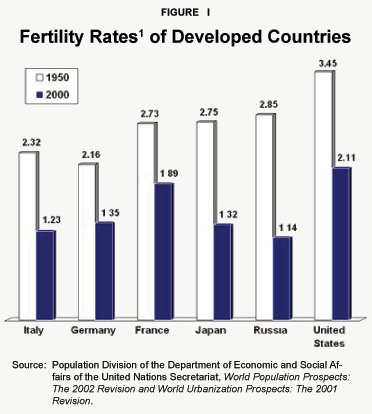
“The number of workers available to pay their benefits will rise by less than 10%.”
Readers of this report are about to experience the greatest demographic change in human history. The largest part of the change will happen in the next 30 years — as 77 million baby boomers in the United States cease to work and pay payroll taxes and instead retire and collect benefits. Even more dramatic changes will occur outside the United States, in countries whose fiscal futures are more dire than our own.
In The Coming Generational Storm, Kotlikoff and Burns ask the reader to imagine what the United States will look like in the year 2030. “What do you see?” They reply:3
“Fertility rates are falling in developed countries.”
You see a country whose collective population is older than that in Florida today. You see a country where walkers outnumber strollers. You see a country with twice as many retirees but only 15 percent more workers to support them. You see a country with large numbers of impoverished elderly citizens languishing in understaffed, overcrowded, substandard nursing homes.
“The decline in the population of Europe will offset the rise in the United States.”
You see a government in desperate trouble. It’s raising taxes sky high, drastically cutting retirement and health benefits, slashing defense, education, and other critical spending, while borrowing far beyond its capacity to repay. It’s also printing tons of money to “meet” its bills.
All developed countries are facing similar bleak futures due to rising life expectancies and falling birthrates. Life expectancy grew dramatically in the last century, a trend that is likely to continue:4
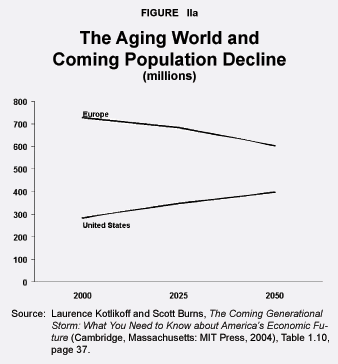
- At the beginning of the 20th century life expectancy was only 47 years, the average American was 23 years old (median age) and only 4 percent of the population was 65 or older.
- Today, life expectancy at birth is 76 years — a gain of 29 years; the average person is 36 years old and 12 percent of the population is age 65 or older.
“Most developed countries’ populations will decline — even with immigration.”
At the same time that those who are born can expect to live longer, fewer people are being born. One measure of the birth rate is the fertility rate — the average number of lifetime births per woman — and this number has been falling in most countries around the world for some time. In general, a fertility rate of 2.1 is needed to replace the population in developed nations. Currently, the United States is hovering at about that point. Most other developed countries, however, are well below it. As Figure I shows:
- In Italy (a Catholic country!) the fertility rate is only 1.2.
- In Germany and Japan the rate is about 1.3.
“The world has never seen fertility rates this low.”
The world has never seen fertility rates this low, and the consequences are striking. For one thing, countries below the replacement rate will see their populations peak and then decline. Although Figure IIa shows that the United States will gain about 100 million people over the next 50 years, this growth will be offset by the loss of 100 million people in Europe. Figure IIb shows the expected 50-year population decline for selected countries, with significant contractions in Japan, Germany, Italy and Russia.
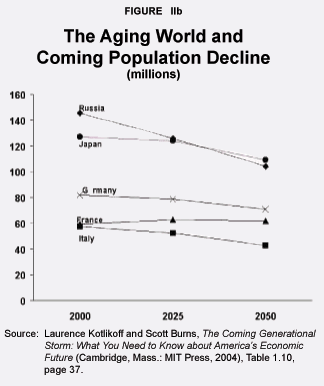
“The average median age will rise.”
Another consequence is that the average age in developed countries will continue to rise. As Figure III shows:
- By mid-century, the average person in the United States will be 41 years old.
- The average person in Europe will be 50 and in Japan 53.
“By 2030, there will be only about two workers for every retiree.”
Aging throughout the developed world will also create enormous financial pressures, given the pay-as-you-go nature of many government entitlement programs. Back in 1950, the average number of workers per Social Security beneficiary in the United States was 16.5. By 2000, the ratio had fallen to 3.4 — about three workers per retiree. By 2030 we will be down to about two workers for every retiree. Over the 80 year period from 1950 to 2039, the intrinsic cost of supporting a retiree will increase eightfold.
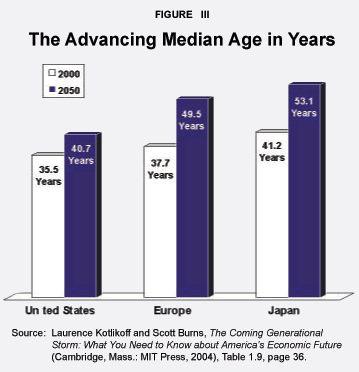
This paper relies on a dynamic, intergenerational and interregional demographic life-cycle model. The model has three regions — the United States, the European Union and Japan — which exchange goods and capital. We carefully model the fiscal institutions of each region, including their pay-as-you-go government pension systems.5
“Our projections are based on optimistic assumptions about fertility rates and health care costs — the reality is likely to be far worse.”
In general, the assumptions behind the model are similar to the “intermediate” assumptions used in the United States by the Social Security Trustees and the Congressional Budget Office. However, in two respects we adopt assumptions that are extremely optimistic: (1) We assume that the long-term decline in fertility rates will reverse over time and eventually converge at the replacement rate (2.1); and (2) We assume that the growth of health care costs per beneficiary will slow and eventually grow no faster than the rate of growth of real per capita wages — even though they have grown 16 times faster over the past three years.
As a result of these very conservative modeling assumptions, the results reported here err on the side of optimism. Reality is likely to be far worse.
[page]“The closed economy simulation assumes no capital flows.”
Our first set of simulations treats the three countries — the United States, Germany and Japan — as closed economies. This means that we assume no trade and no capital flows and that each region is a self-contained economic unit. This type of simulation is especially useful as a point of comparison for the international effects of aging in the open economies model (discussed below).
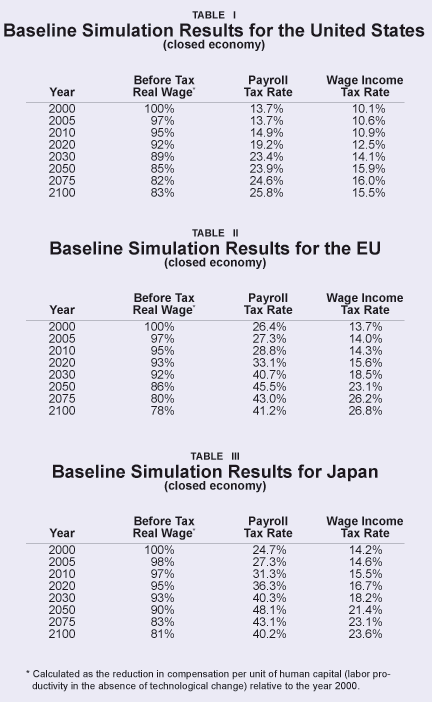
Baseline Simulations. Tables I, II and III give selected results for each of the three regions, with Social Security payroll tax rates and the income tax rate on labor reported in the right two columns. As Table I shows:
- In order to finance elderly benefits in the United States, the payroll tax must climb from 14 percent (the current pure pay-as-you-go rate) to 23 percent over the next 30 years, while the average income tax will rise from 10 percent to 14 percent.
- The total tax on wages will rise from 24 percent to 38 percent by 2030 and to 40 percent by mid-century.
“Higher taxes and less saving will create a capital shortage.”
Higher taxes mean lower after-tax income for workers. But they also have another, highly damaging effect. Less disposable income means less saving; less saving means less capital formation; less capital formation means lower labor productivity; and lower labor productivity means lower real wages.
Specifically:
- Because of lower capital stock, the real wages of U.S. workers will be 11 percent lower than they otherwise would have been by 2030 and 15 percent lower by the middle of this century.
- Combining reduced before-tax wages with expected higher tax rates implies that future workers must settle for a 25 percent cut in their standard of living by 2030.
- By mid-century, the growth of elderly entitlements will create an American standard of living one-third lower than it otherwise would have been.
“Living standards will fall.”
Bad as these results are, the simulation for Europe is much worse — because fertility rates are lower and population aging is more severe. As Table II shows:
- In Europe, where the total tax on wages is already above 40 percent, the total tax burden will rise to almost 60 percent by 2030 and approach a staggering 70 percent by mid-century.
- Combining these tax rates with an 8 percent fall in real wages from relative capital contraction implies a 25 percent reduction in the average European workers’ standard of living over the next 30 years.
- By mid-century, the relative fall in standard of living for European personnel will be close to 40 percent.
“By 2050, United States real wages will be 15% lower than otherwise and taxes on labor will approach 40%.”
The Japanese workforce already bears a tax on wages in excess of 40 percent, and its aging society will cause the payroll tax to double over the next 50 years. The overall results are similar to those for Europe. As Table III shows:
- By 2030, the total tax on labor in Japan will approach 60 percent and Japanese workers will face a one-fourth reduction in their living standard.
- By the middle of this century, the effects of elderly entitlements will push the Japanese tax on labor to 70 percent and living standards for Japanese workers will be 40 percent lower than they otherwise would have been.
“In the EU, taxes will claim two-thirds of wages.”
As one would expect from the population dynamics described above, the largest increase in payroll tax rates in the medium term occurs in Japan, where they double from 24.7 percent to 48.1 percent in the next 50 years. While European payroll tax rates are currently higher than Japan’s, their future increase is somewhat less pronounced, and they peak at 45.5 percent. Because the aging rate is less severe in the United States, Social Security taxes will rise less —from 13.7 percent in 2000 to 23.4 percent in 2030 and to 25.8 percent by the end of the century.
“In Japan, the total tax on labor will approach 70%.”
The picture is very similar in the case of income taxes. Due to generous public expenditures per capita in Europe, average income taxes on wages must increase steadily over the whole transition in order to balance the budget. While the current average rate is 13.7 percent, it almost doubles by 2100, reaching 26.8 percent. In Japan the average wage tax rate rises from 14.2 percent to 23.6 percent. In the United States, where public expenditures per capita are generally lower, the average wage income tax rate equals 10.1 percent in 2000, peaks at 16.0 percent in 2075 and falls to 15.5 percent by century’s end.
“In the open economy simulation, Europe and Japan bid capital away from the United States.”
To summarize, our closed economy, baseline policy simulations reveal a severe deterioration in macroeconomic and fiscal conditions in all three regions.
[page]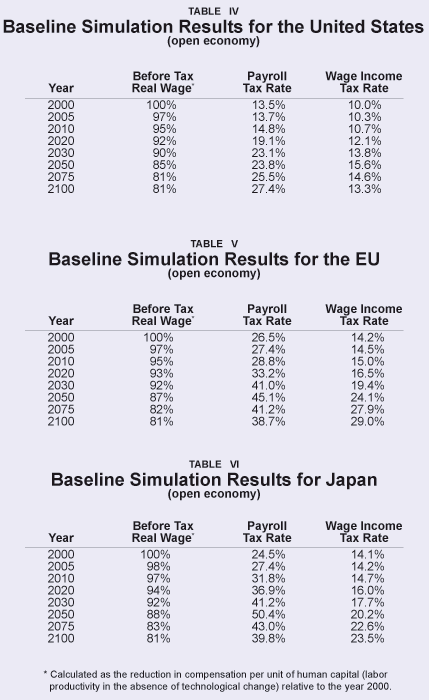
“International competition for capital will raise the interest rate by 440 basis points.”
As noted, the key assumption behind our closed economy simulations is that capital does not flow across borders. In all three regions, a relative capital shortage causes real interest rates to rise. In fact, by the end of the century they will be 3.2 percentage points higher in the United States, and 6.6 and 4.8 percentage points higher in Europe and Japan, respectively.
“By mid-century, the standard of living of U.S. workers will be one-third lower than otherwise.”
Ordinarily, one would expect that access to international capital markets (as is assumed in the open economies simulation) would benefit a U.S. economy in need of capital. However, in this case, conditions in Europe and Japan are much worse. So the other two regions end up bidding capital away from the United States. By the end of the century, the uniform international interest rate will be 4.4 percentage points (440 basis points) higher than at the beginning. As a result, international competition for capital raises rates in the United States, even as it lowers rates in Europe and Japan.
“In Europe and Japan, the fall in living standards will be close to 40%.”
As Table IV, V and VI show, the macroeconomic structures of the open and closed economy models are very similar, with some differences worth mentioning. In the closed economy baseline, interest rates increase the most in Europe and the least in the United States. Consequently, in the open economy, capital flows predominantly from the U.S. toward Europe. The baseline path of the open economy, therefore, in contrast to the respective closed economy cases, allows for more capital accumulation for Europe and less for the United States. Japan experiences initial capital outflows that eventually change to inflows. Due to these changes, the United States and Japan experience short-run current account surpluses while the European Union faces current account deficits. As a result:
“Because the problem of aging will be worse in Europe and Japan, economic deterioration in those regions will affect the U.S. economy.”
- U.S. real wages by 2100 are about 2 percentage points lower than in the closed economy model, reflecting a lower capital stock thanks to the export of capital to Europe and Japan (see Table IV).
- Roughly the reverse happens in Europe, where the long-run real wage is about 3 percent higher than in the closed economy model, reflecting the relatively smaller reduction in the capital stock thanks to the import of capital from the United States (see Table V).
- In the long run, Japan is largely unaffected by the choice of models. (See Table VI.)
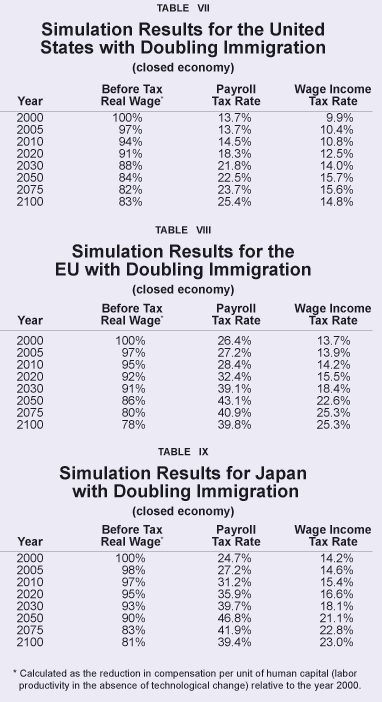
“Though immigrants pay more taxes, they also earn benefits.”
Increased immigration is often mentioned as a way to ease the burdens that will be imposed by the aging populations of developed countries. Will this policy option solve the problem?
Importing additional workers will certainly raise the payroll tax base. But more immigrants also mean increased expenditures on education, public safety, water and sewer systems, and a host of other public goods, including pension and health care benefits. Immigrants also accrue their own rights to pension and health care benefits. Moreover, most developed countries provide benefits to the elderly on a progressive basis. And since immigrants tend to be disproportionately low-wage earners, they typically receive more benefits per dollar of tax payments than do native workers.
“Doubling immigration would have little long-run effect.”
Closed Economy Simulation. We assume a doubling of immigration in each region starting in 2001 and continuing through 2050. This means that every year over the next half century the United States experiences immigration of 2 million people, Europe 900,000 people, and Japan 108,000 people.
“Europe’s exorbitant tax rates are reduced in the long run by only 3 percentage points.”
Even though the proportional increase is the same in all three regions, the quantitative impact of immigration policy is quite different. In the United States, the effective labor supply will be 13 percent larger in 2030 and 31 percent larger in the year 2100. Taken alone, one would expect this to lower tax rates considerably. But the immigrants necessitate increased spending on public goods and they acquire their own entitlement benefits. Consequently, combined taxes on labor income fall from 37.5 percent to only 35.8 percent in 2030 and from 41.3 percent to only 40.2 percent by the end of the century. (See Table VII vs. Table I.)
“In Japan the reduction is only 1.4 percentage points.”
In Europe, immigration is lower than in the United States. Consequently, doubling immigration in Europe has a smaller effect on the macroeconomy. Effective labor supply increases by only 6.5 percent in 2030 and by 21 percent in 2100. However, Europe benefits more from immigration due to its more extreme population aging. Payroll and wage income taxes fall from 59.2 percent of income to 57.5 percent by 2030 and from 68.0 percent to 65.1 percent by 2100. (See Table VIII vs. Table II.)
“The effect of immigration is similar when trade and capital flows are included.”
Japan sees very modest immigration. Doubling immigration increases the effective labor supply by only 2.5 percent in 2030 and 10 percent in 2100. Therefore, the impact on payroll and wage taxes is also modest. The tax on labor income will fall from 58.5 to 57.8 percentage points by 2030 and from 63.8 to 62.4 percent by 2100. (See Table IX vs. Table III.)
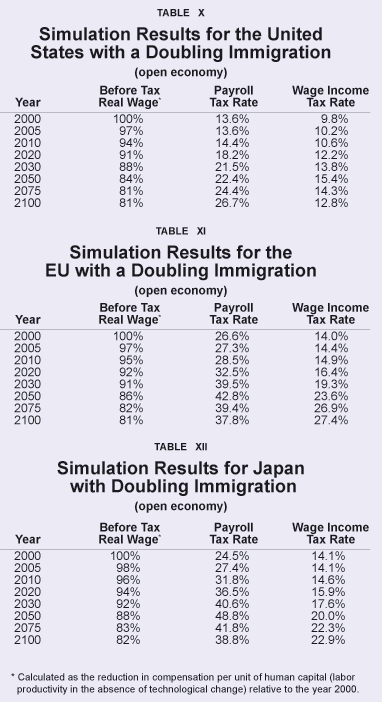
Europe’s, exorbitant tax rates are reduced in the long run by only 3 percentage points. In Japan, the long run reduction is only 1.4 percentage points. In the United States the long run reduction is even smaller.
Open Economy Simulation. Though the doubling of immigration in open economies is very similar to that of the closed economies, capital flow shifts cause additional immigration to have a different impact on the world interest rate. Compared to the closed economy model, interest rate reductions are weaker in Europe, and the increase is stronger in the United States and Japan. Consequently, Europe’s capital income taxes fall less, and progressive wage taxes increase less compared to the closed economy. (See Tables X, XI and XII vs. Tables IV, V and VI.)
[page]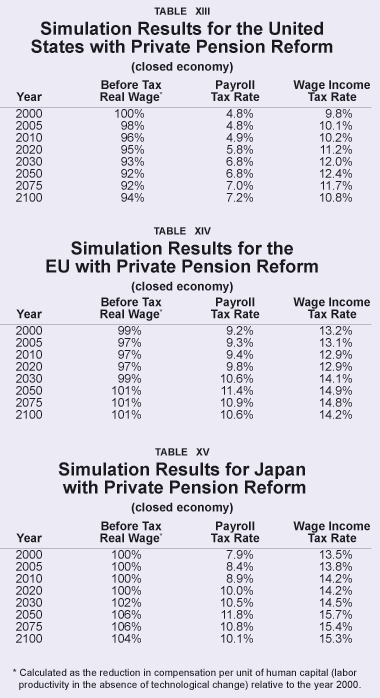
“Pension reform would allow workers to invest their payroll taxes in private accounts.”
Our proposed pension privatization reform eliminates existing public pension systems at the margin, while still paying successive retirees all the benefits they accrued under the existing system. This reform is modeled in the following way: Pension benefits of current retirees are paid in full, and benefits for new retirees are phased out linearly over a 45-year period starting in 2000. Furthermore, payroll tax contributions to the pension system are eliminated, and transitional benefits are financed by a new consumption tax, such as a general national sales tax or Value-Added Tax.6
“A transitional consumption tax would increase saving and capital formation.”
Closed Economy Simulation. In the United States, the new consumption tax rate needed to finance the transition to a private pension system is initially 7.9 percent. It rises to a maximum value of 8.7 percent in 2020 and gradually declines thereafter. After 2071 the consumption tax is zero. The U.S. payroll tax rate declines immediately by 6.2 percentage points. Over the transition, the payroll tax rate rises by 2.4 percentage points because expenses for health care and disability insurance grow. In Europe, a similar consumption tax rate would have an initial value of 16.9 percent, rising to a maximum of 18 percent in 2012 and then decline. The tax is zero after 2074. Because of this reform, the payroll tax is reduced by 17.2 percentage points in year 2000 and rises to a maximum of 11.4 percent in 2050. In Japan, the added consumption tax rate is initially 14.2 percent. It rises to a maximum of 18.3 percent in 2014 before declining. As in Europe, the targeted consumption tax is zero after 2074. The payroll tax, however, is 16.8 percentage points lower in 2000 and the maximum value reached is 11.8 percent in 2050.
The impact of this reform on the U.S. economy is stunning (see Table XIII vs. Table I):
- Whereas without reform, the relative real wages of U.S. workers are expected to decline by 15 percent at mid-century, with reform the drop is only 8 percent;
- Whereas combined taxes on U.S. labor income is expected to approach 40 percent without reform, with reform taxes on labor will be less than half as much.
The effects on European economies are even more dramatic (see Table XIV vs. Table II):
“By 2050, U.S. real wages would fall by 8% instead of 15% and the tax on labor would be cut in half.”
- Instead of a 14 percent drop in relative real wages by 2050, European workers will actually see a real wage increase.
- Without reform, European workers can expect to pay two of every three future dollars they earn in taxes, whereas after reform, taxes will claim only one in four dollars earned.
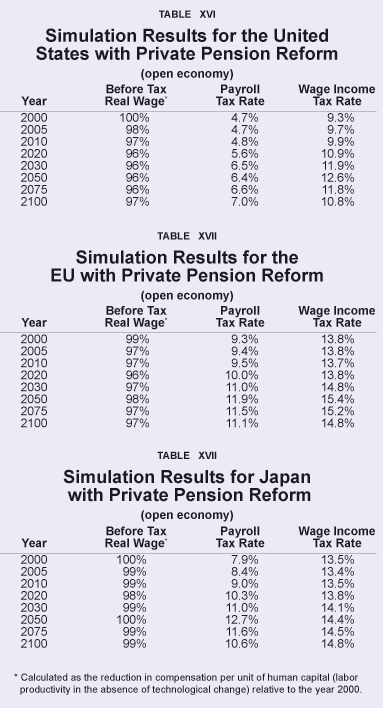
“In Europe, real wages would actually rise and taxes on labor would fall to 25%.”
Results are similar in Japan, where the real wage gains and tax reductions are even greater (see Table XV vs. Table III).
Note that the consumption tax depresses aggregate consumption, which permits an increase in national saving and capital formation. The long-run consequences of this reform are dramatic in all three regions.
- Relative to the base case simulations, the year 2100 capital stock increases by 62.9 percent in the United States, 163.5 percent in Europe and 149.3 percent in Japan.
- Higher capital stocks increase gross wages, which, relative to the base case, rise through 2100 by 13 percent in the United States, 29 percent in Europe and 28 percent in Japan.
- The combination of higher gross wages and reduced payroll and wage taxes boosts net wages especially in Europe and Japan: they almost triple in Europe and more than double in Japan relative to the base case.
“In Japan, wage gains and tax reductions would be even greater.”
A reduction in the labor supply in the three regions is a direct consequence of the positive income effects experienced by younger generations. Capital accumulation drives up capital valuations in all economies and leads to lower long-run interest rates.
Open Economies Simulation. Not surprisingly, the consequences of private pension reform in an open economy are very similar to those in the closed economies simulation. (See Tables XVI, XVII and XVIII vs. Tables IV, V and VI.)
“In the open economy simulation, trade and capital flows make reform a better deal for U.S. workers.”
In the United States, the consumption tax increases slightly less in the open economies model than in the closed economies model, whereas in Europe the consumption tax increases slightly more. The reason is that privatization has a stronger positive effect on wages in the open U.S. economy compared to the closed U.S. economy, while the opposite applies in the EU and Japan. Finally, the drop in the interest rate due to privatization is greater in the open than in the closed U.S. economy. In Europe and Japan exactly the opposite happens.
[page]“A consumption tax would spread the transitional costs among generations.”
The advantageous macroeconomic effects of privatization come at a cost. Private pension reform implies a redistribution from older generations in all three economies toward younger and future generations. The intergenerational and intragenerational redistribution is less severe in the United States than in Europe and Japan, however. This is because part of the financing burden of the pension system is shifted toward the elderly via the consumption tax. How substantial are these gains and losses?
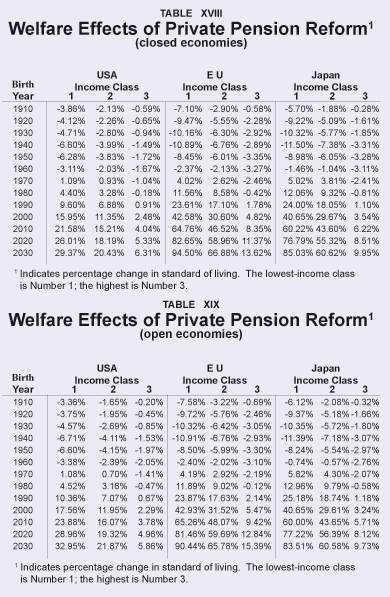
“The benefits of reform are greatest for younger, low-income workers.”
Closed Economies Simulation. Table XVIII shows the impact (relative to the base case) of pension reform on the remaining lifetime welfare of different groups of workers. In the table, the groups are distinguished by their year of birth and income levels. The welfare change is calculated by asking by what percentage would one need to increase a person’s annual consumption and leisure in the base case to achieve the same level of wellbeing with private pension reform.
There are two striking features about this table:
- Among younger workers (especially those yet to be born), the long run benefits of a reformed system are very large and very progressive.
- Among older workers (retirees) the costs of reform are relatively small but somewhat regressive.
Consider the generation of workers who will be born three decades hence. If private pension reform were instituted today:
- In the United States, the lowest-income workers born in 2030 will experience a 30 percent increase in their standard of living; middle-income workers will enjoy a 20 percent increase; and the highest income workers will gain a mere 6 percent.
- In Europe the gains are even more dramatic: almost a doubling of living standards (95 percent) for the lowest-income group, a two-thirds increase for those in the middle and a 14 percent gain for those at the top.
- In Japan, the gains are 85 percent, 61 percent and 10 percent, respectively.
By contrast, older workers (through the consumption tax) will bear a net cost as a result of this reform. For example:
“Because of reform, a middle income worker born in the USA will see a 22% increase in living standards.”
- Low-income U.S. retirees born in the 1940s will see a 6.6 percent drop in their living standard because of the consumption tax, compared to a 1.5 percent drop for higher-income retirees.
- In Europe the comparable numbers are 10.9 and 2.9 percent.
- In Japan they are 11.5 and 3.3 percent.
Note, however, that senior citizens who would bear a disproportionate cost under this proposal are the very people who have disproportionately gained from the current system. Note also that many consumption tax proposals are combined with measures to give relief to lower income taxpayers and such features could be added to this reform as well.
“Middle-income workers born in 2030 in Europe and in Japan will see gains of 60% or greater.”
Open Economies Simulation. The open economy welfare effects are quite similar to the closed economy effects, but some differences should also be mentioned. In the United States the elderly lose more in the closed than in the open economy model, while the opposite happens in Europe and Japan. This is due to the above-mentioned changes in consumption tax rates. On the other hand, long-run intragenerational redistribution favors the European top income class in the open economy more than in the closed economy. The opposite happens in the United States. Again, this is due to the long-run interest rate, which decreases less in the European open economy; consequently, progressive wage taxes are lower.
[page]“Population aging is more dramatic in Europe and Japan, but all three regions’ economies will be damaged without reform.”
In this paper, we assume that governments collect the taxes needed to pay all entitlement benefits. We use a new dynamic simulation model to analyze the general equilibrium economic impact on the world’s three major industrialized regions: the United States, Europe and Japan. Our simulations show that aging will greatly damage all three regional economies. In particular, it will generate a significant capital shortage.
However, population aging is not identical in all three areas. It is more dramatic in Japan and Europe than in the United States. Consequently, the macroeconomic impacts of aging are somewhat different in the three regions. These differences will cause capital to flow from the United States to Europe and Japan. Stated differently, the U.S. capital shortage will be exacerbated by the need to supply capital to Japan and the European Union.
Although increased immigration has some beneficial macroeconomic effects, they are extremely small. On the other hand, one can expect a significant long-run improvement from eliminating current pay-as-you-go pension systems and replacing them with funded, private retirement accounts, financed by an earmarked consumption tax. While the welfare losses of the elderly and near-elderly are modest, the welfare gains for younger and future generations (especially those with low and middle incomes) are extraordinarily large.
In conclusion, the generational storm approaching the shores of the developed world is much more threatening than is commonly believed. However, the situation is not completely hopeless. There are policies, albeit painful ones, that can materially improve the developed world’s long-term prospects.
NOTE: Nothing written here should be construed as necessarily reflecting the views of the National Center for Policy Analysis or as an attempt to aid or hinder the passage of any bill before Congress.
[page]- Were aging to raise the stock of capital compared to the supply of labor, real wages would increase and, thereby, expand the taxable wage base. This would limit the need for higher payroll taxes. The prospect of a capital stock increase arises from the fact that the elderly are the primary owners and, thus, the main suppliers of capital, while the young are the main suppliers of labor. All else equal, more oldsters relative to youngsters means a greater supply of capital relative to labor. Unfortunately, all else will not be equal. In particular, if benefits are paid as promised, the requisite tax increases will undermine capital formation as workers’ wages, some of which would otherwise be saved, are taken from them and handed over to the elderly to finance immediate consumption.
- Measured in units of human capital, or productivity absent technological change.
- Laurence Kotlikoff and Scott Burns, The Coming Generational Storm: What You Need to Know about America’s Economic Future (Cambridge, Mass.: MIT Press, 2004), page xi.
- Ibid., pages 2, 36.
- For a technical description of the model used in this report, see Hans Fehr, Sabine Jokisch and Larry Kotlikoff, “The Developed World’s Demographic Transition – The Roles of Capital Flows, Immigration and Policy,” unpublished paper, October 2003. Available at http://econ.bu.edu/kotlikoff/demotransfinal.pdf.
- Laurence J. Kotlikoff, “Privatizing Social Security,” National Center for Policy Analysis, NCPA Policy Report No. 217, July 1998.
Laurence J. Kotlikoff, a senior fellow with the National Center for Policy Analysis, is Professor of Economics at Boston University, Research Associate of the National Bureau of Economic Research, Fellow of the Econometric Society, a member of the Executive Committee of the American Economic Association and President of Economic Security Planning, Inc., a company specializing in financial planning software.
Professor Kotlikoff received his B.A. in Economics from the University of Pennsylvania in 1973 and his Ph.D. in Economics from Harvard University in 1977. From 1977 through 1983 he served on the faculties of economics of the University of California, Los Angeles and Yale University. In 1981-82 Professor Kotlikoff was a Senior Economist with the President’s Council of Economic Advisers.
Professor Kotlikoff has served as a consultant to the International Monetary Fund, the World Bank, the Harvard Institute for International Development, the Organization for Economic Cooperation and Development, the Swedish Ministry of Finance, the Norwegian Ministry of Finance, the Bank of Italy, the Bank of Japan, the Government of Russia, the Government of Bolivia, the Government of Bulgaria, the Treasury of New Zealand, the Office of Management and Budget, the U.S. Department of Education, the U.S. Department of Labor, the Joint Committee on Taxation, the Commonwealth of Massachusetts, the American Council of Life Insurance, and Merrill Lynch, Fidelity Investments and other major U.S. corporations. He has provided expert testimony on numerous occasions to committees of Congress.
Professor Kotlikoff is coauthor (with Alan Auerbach) of Macroeconomics: An Integrated Approach and Dynamic Fiscal Policy; author of Generational Accounting, What Determines Savings?; coauthor (with Daniel Smith) of Pensions in the American Economy; and coauthor (with David Wise) of The Wage Carrot and the Pension Stick. In addition, he has published extensively in professional journals, newspapers and magazines.